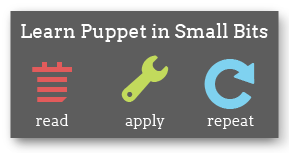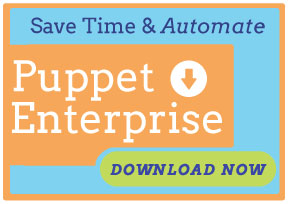Environments
Manage your module releases by dividing your site into environments.
Slice and Dice
Puppet lets you slice your site up into an arbitrary number of “environments” and serve a different set of modules to each one. This is usually used to manage releases of Puppet modules by testing them against scratch nodes before rolling them out completely, but it introduces a lot of other possibilities, like separating a DMZ environment, splitting coding duties among multiple sysadmins, or dividing the site by hardware type.
What an Environment Is
Every agent node is configured to have an environment, which is simply a short label specified in puppet.conf’s environment setting. Whenever that node makes a request, the puppet master gets informed of its environment. (If you don’t specify an environment, the agent has the default “production” environment.)
The puppet master can then use that environment several ways:
- If the master’s
puppet.conffile has a[config block]for this agent’s environment, those settings will override the master’s normal settings when serving that agent. - If the values of any settings in
puppet.confreference the$environmentvariable (likemodulepath = $confdir/environments/$environment/modules:$confdir/modules, for example), the agent’s environment will be interpolated into them. - Depending on how
auth.confis configured, different requests might be allowed or denied. - The agent’s environment will also be accessible in Puppet manifests as the top-scope
$environmentvariable.
In short: environments let the master tweak its own configuration on the fly, and offer a way to completely swap out the set of available modules for certain nodes.
Naming Environments
Environment names should only contain alphanumeric characters and underscores, and are case-sensitive.
Caveats
Before you start, be aware that environments have some limitations, most of which are known bugs or vagaries of implementation rather than design choices.
- Puppet will only read the
modulepath,manifest,manifestdir, andtemplatedirsettings from environment config blocks; other settings in any of these blocks will be ignored in favor of settings in the[master]or[main]blocks. (Issue 7497) - File serving only works well with environments if you’re only serving files from modules; if you’ve set up custom mount points in
fileserver.conf, they won’t work in your custom environments. (Though hopefully you’re only serving files from modules anyway.) - Prior to Puppet 3, environments set by external node classifiers were not authoritative. If you are using Puppet 2.7 or earlier, you must set the environment in the agent node’s config file.
- Serving custom types and providers from an environment-specific modulepath sometimes fails. (Issue 4409)
Configuring Environments on the Puppet Master
In puppet.conf
As mentioned above, puppet.conf lets you use $environment as a variable and create config blocks for environments.
# /etc/puppet/puppet.conf
[master]
modulepath = $confdir/environments/$environment/modules:$confdir/modules
manifest = $confdir/manifests/unknown_environment.pp
[production]
manifest = $confdir/manifests/site.pp
[dev]
manifest = $confdir/manifests/site.pp
In the [master] block, this example dynamically sets the modulepath so Puppet will check a per-environment folder for a module before serving it from the main set. Note that this won’t complain about missing directories, so you can create the per-environment folders lazily as you need them.
The example also redirects requests for a non-existent environment to a different site manifest, which will log an error and fail compilation; this can keep typos or forgetfulness from silently causing odd configurations.
In auth.conf
path /
auth true
environment appdev
allow localhost, customapp.example.com
If you specify an environment in an auth.conf ACL, it will only apply to requests in that environment. This can be useful for developing new applications that integrate with Puppet; the example above will leave normal requests functioning normally, but allow an app server to access everything via the REST API.
In Manifests
The $environment variable should only rarely be necessary, but it’s there if you need it.
Configuring Environments for Agent Nodes
In an ENC
Your external node classifier can set an environment for a node by setting a value for the environment key. In Puppet 3 and later, the environment set by the ENC will override the environment from the agent node’s config file. If no environment is provided by the ENC, the value from the node’s config file will be used.
Note: In Puppet 2.7 and earlier, ENC-set environments are not authoritative, and using them results in nodes using a mixture of two environments — the ENC environment wins during compilation, and the agent environment wins during file downloads. If you need to centrally control your nodes environments, you should upgrade to Puppet 3 as soon as is practical.
As a temporary workaround, you can manage nodes’ puppet.conf files with a template and set the environment based on the ENC’s value; this will allow nodes to use a consistent environment on their second (and subsequent) Puppet runs.
Note: If your puppet master is running Puppet 3 but was once running Puppet 2.6, its auth.conf file may be missing a rule required for ENC environments. Ensure that the following rule exists somewhere near the top of your auth.conf file:
# allow nodes to retrieve their own node definition path ~ ^/node/([^/]+)$ method find allow $1Puppet masters which have only run 2.7 and later should already have this rule in their auth.conf files.
On the Agent Node
To set an environment agent-side, just specify the environment setting in either the [agent] or [main] block of puppet.conf.
[agent]
environment = dev
Note that in Puppet 3 and later, this value will only be used if the ENC does not override it.
As with any config setting, you can also temporarily set it with a command line option:
# puppet agent --environment dev
Compatibility Notes
Environments were introduced in Puppet 0.24.0.

